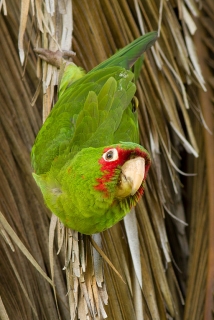Red-masked Conure |
|
|
Also known as: Red-masked Parakeet, Red-headed Conure, Cherry-headed Conure
Photos
View in GalleryDid You Know?
The Red-masked Conure will nest in a variety of places - from mature trees to termite nests; also one report of a nest in a cliff.Academic Research
Related publications: Psittacara erythrogenysSpecies Profile
Genus: Psittacara | Species: erythrogenys
Size:
33cm (12.8 in)
Weight:
165-200g (5.8-7 oz)
Subspecies including nominate:
one
Colour Adult:
Both adults green in general, more yellow on underparts; red forecrown to lores and forecheeks; red bend of wing, carpal edge, outer underwing coverts and thighs. Bill horn in colour. Eye ring bare and buff/white. Eye dull yellow with grey inner ring.
Colour Juvenile:
Head all green, red markings absent; green thighs, yellow/green carpal edge, with varying orange/red feathers; less extensive red on bend of wing and outer underwing coverts. Eye grey.
Call:
Calls made in flight or when perched are raspy and screechy. Also louder, rasping and rapid-short two-note calls, the second note longer. Also buzzing notes.
Video Links:
Video 1 | Video 2 | Video 3More Information:
Content Sources:
CITES
BirdLife International
Cornell Lab of Ornithology/Birds of the World
A Guide to Parrots of the World, Juniper and Parr, 1998
Parrots of the World, Forshaw and Cooper, 1977. 2010 edition
Parrots of the World, Forshaw, 2006.
Parrots in Aviculture, Low, 1992.
Psittacine Aviculture, Schubot, Clubb and Clubb, 1992.
Photos
View in GalleryDid You Know?
The Red-masked Conure will nest in a variety of places - from mature trees to termite nests; also one report of a nest in a cliff.Academic Research
Related publications: Psittacara erythrogenysSpecies Care
Captive Status:
Uncommon
Longevity:
Up to 25 yrs; 10-15 average.
Housing:
Aviary or suspended enclosure, 2-3m (6.5-9.8 ft), metal construction.
Diet:
Fruit such as: apple, pear, orange, banana, pomegranates, kiwi, papaya, cactus fruits, forming about 30 percent of the diet; vegetables such as: carrot, celery, green beans and peas in the pod; fresh corn on the cob; green leaves such as: Swiss chard, lettuce, kale, sowthistle, dandelion, chickweed; spray millet; small seed mix such as: canary, millet and smaller amounts of oats, buckwheat, safflower and a little hemp; soaked and sprouted sunflower seed; cooked beans and pulses, boiled maize; complete kibble.
Enrichment:
Vigorous chewers, so provide bird-safe, unsprayed flowering, fir, willow, elder and pine branches; heat sterilized pine cones, wooden block and vegetable tanned leather toys, swings, ladders, ropes and puzzle/foraging toys.
Nest Box Size:
Vertical box 12" x 12" x 18" (30.5cm x 30.5cm x 45.7cm).
Clutch Size:
3-4
Incubation Time:
24 days
Fledging Age:
7-9 weeks
Hatch Weight:
Probably 10-11g (0.35-0.38 oz)
Peak Weight:
Not recorded.
Weaning Weight:
Not recorded.
Photos
View in GalleryDid You Know?
The Red-masked Conure will nest in a variety of places - from mature trees to termite nests; also one report of a nest in a cliff.Academic Research
Related publications: Psittacara erythrogenysSpecies Wild Status
World Population:
About 10,000
IUCN Red List Status:
Near Threatened
CITES Listing:
Appendix II
Threat Summary:
A restricted-range species. Is threatened from the local wild bird trade in Peru and Ecuador, where mortality rates from poor handling and stress are high.
Range:
Lowlands and Pacific slope of W Ecuador and NW Peru, south to Lambayeque and Cajamarca. Introduced to Florida, California, US and Grand Cayman Island, Greater Antilles.
Habitat:
Found up to 2500m (8200 ft) in a variety of arid and humid areas including humid evergreen forest, deciduous forest, dry thorny scrub, degraded and fragmented forests, farmed areas with scattered trees, and near city areas.
Wild Diet:
Diet includes Saponas purpurea (Anacardiaceae), Hyeronima alchorneoides, Ceiba trischistandra Bombacaceae seeds, Bursera graveolens Burseraceae, and Eriotheca ruizii Bombacaceae seeds. Foods eaten by feral birds in California include: Plantanus, Plane tree, Myoporum laetum, Mouse hole tree; Cotoneaster, Celtis, Hackberry, Eucalyptus, Tecomeria capensis, Cape honeysuckle; and commercial birdseed. Also Juniperus, Juniper seed cones; Pinus canariensis, Canary Island Pine nuts, Malus domestica, apples; Eriobotrya japonica, Loquat, Psidium cattleianum, Strawberry guava; Pyrus communis, pears, Cotoneaster frigidus, Cotoneaster seeds, Crataegus monogyna, Common hawthorn seeds and pulp.
Ecology and Behaviour:
Social and active, particularly outside of breeding season. Seen in groups of up to 12 birds with larger flocks of around 200 at communal roosts. May be seen in mixed flocks with Grey-cheeked Parakeets and Bronze-winged Parrots.
Clutch and Egg Size:
3-4 rounded eggs, 31.0 x 25.5mm (1.2 x 1 in).
Breeding Season:
January-March; nest is in limb hollow or tree cavity.
Related Links:
Photos
View in GalleryDid You Know?
The Red-masked Conure will nest in a variety of places - from mature trees to termite nests; also one report of a nest in a cliff.Academic Research
Related publications: Psittacara erythrogenysMembers Only Resources
Please log-in now to find more research, resources and tools.
Not a Member?
Find more great information:
Gain exclusive access to 600+ pages of additional research, seminars and podcasts, specialists to ask your toughest questions, and dozens of other fun resources - when you become a WPT member.
Join Today >>

































